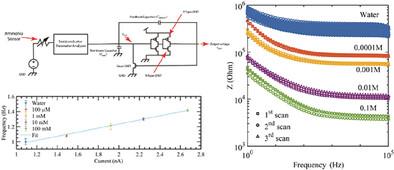当前位置:
X-MOL 学术
›
Adv. Electron. Mater.
›
论文详情
Our official English website, www.x-mol.net, welcomes your
feedback! (Note: you will need to create a separate account there.)
Aqueous Ammonia Sensor with Neuromorphic Detection
Advanced Electronic Materials ( IF 5.3 ) Pub Date : 2024-11-19 , DOI: 10.1002/aelm.202400509 Kateryna Vyshniakova, Mohammad Javad Mirshojaeian Hosseini, Huiwen Bai, Masoome Fatahi, Victor Marco Rocha Malacco, Shawn S Donkin, Richard M Voyles, Robert A. Nawrocki
Advanced Electronic Materials ( IF 5.3 ) Pub Date : 2024-11-19 , DOI: 10.1002/aelm.202400509 Kateryna Vyshniakova, Mohammad Javad Mirshojaeian Hosseini, Huiwen Bai, Masoome Fatahi, Victor Marco Rocha Malacco, Shawn S Donkin, Richard M Voyles, Robert A. Nawrocki

|
A hybrid inorganic–organic neuromorphic sensor utilizing a thin film zinc oxide (ZnO) detector with organic neuromorphic pre-processing is developed to quantify ammonia in aqueous environments, including biological analytes. Impedimetric ZnO sensor, connected to an organic somatic circuit, reliably and accurately detects changes in electrical impedance to measure and quantify variations in the concentration of ammonia. The sensing mechanism of the ZnO thin film sensor is hypothesized to be the cause of the decrease in resistance of a solution with an increase in ammonia concentration. It is found that the surface oxide of the ZnO layer reacts with even very low concentrations of ammonia (
中文翻译:

具有神经形态检测功能的氨水溶液传感器
开发了一种混合无机-有机神经形态传感器,利用薄膜氧化锌 (ZnO) 检测器和有机神经形态预处理来量化水环境中的氨,包括生物分析物。阻抗式 ZnO 传感器连接到有机体细胞电路,可靠、准确地检测电阻抗的变化,以测量和量化氨浓度的变化。据推测,ZnO 薄膜传感器的传感机制是导致溶液电阻随着氨浓度的增加而降低的原因。研究发现,ZnO 层的表面氧化物甚至会与非常低浓度的氨 (
更新日期:2024-11-20
中文翻译:

具有神经形态检测功能的氨水溶液传感器
开发了一种混合无机-有机神经形态传感器,利用薄膜氧化锌 (ZnO) 检测器和有机神经形态预处理来量化水环境中的氨,包括生物分析物。阻抗式 ZnO 传感器连接到有机体细胞电路,可靠、准确地检测电阻抗的变化,以测量和量化氨浓度的变化。据推测,ZnO 薄膜传感器的传感机制是导致溶液电阻随着氨浓度的增加而降低的原因。研究发现,ZnO 层的表面氧化物甚至会与非常低浓度的氨 (


















































 京公网安备 11010802027423号
京公网安备 11010802027423号